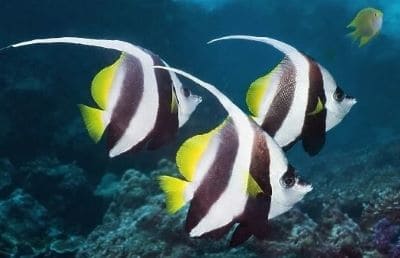Home › Diving Spots › Asia › Thailand › Khao Lak › Underwater Museum
Scuba Diving The Underwater Museum
The Artificial Reef dive site, also known as Tor 13 and Underwater Museum, was launched in 2014 in honour of Her Majesty Queen Sirikit.
This guide contains useful information for divers heading to the Artificial Reef at Khao Lak, with extra details about the marine species living around the sunken ruins.
Central Hub to Explore Underwater Wrecks
Khao Lak is the main focal point for scuba diving in the west of Phang-Nga province (60 km north of Phuket Island).
White sand beaches, and clear blue water, are the distinctive features that visitors first notice about this shoreline.
The stunning backdrop of dense, tropical rainforest is another benefit for tourists visiting this region.
But, most of Khao Lak's visitors come to scuba dive the Similan Islands and the local shipwrecks.
The climate along this part of the Andaman Coast is tropical. Thus, the days are almost always hot and sunny and the average sea temperatures range between 26° and 30° Celsius (78° to 86° Fahrenheit).
The dry months usually begin in October and run through to April. As a result, the best months for scuba diving at Khao Lak are December to February. This is when the underwater visibility can reach up to thirty (30) metres.
Note: Each year, the National Marine Park for Mu Koh Similan and Mu Koh Surin islands opens for scuba activities in November and it closes in May.
Artificial Reef Dive Site
The Khao Lak Underwater Museum diving spot is an artificial coral reef construction located close to the shoreline in front of La Flora Resort, in Bang Niang.
Falling under the supervision of the Royal Thai family, along with the Department of Marine and Coastal Resources, this unique project for scuba divers hosts various types of military equipment, including:
- A former navy patrol boat (Tor 13)
- Collection of open concrete blocks
- Harley Davidson motorbike
- Turtle statue
- Twenty (20) sunken army tanks and trucks
Khaolak Underwater Museum dive site in Phang Nga is only six (6) kilometres from the shore. As a consequence of that, it has become the ideal habitat for more than 150 different marine life species.
Moreover, this underwater learning center caters for aficionados of decommissioned warships scuttled intentionally for recreational scuba diving activities.
Here's the thing:
The Underwater Museum dive site covers an area of approximately one (1) square kilometre. It is quite a shallow spot with an average depth of seventeen (17) metres.
It's a good location for scuba diving on Thai shipwrecks, especially from November to the end of January. But, you may experience turbid water currents and high waves outside these peak months.
Note: Another section explains more about passive interaction with marine animals and the importance of diving safely around hazardous sea life.
Sea Life at Khao Lak Dive Spots
Local divers suggest there could be more than forty different types of natural corals and at least one hundred fish families inhabiting the soft sand dive site at Artificial Reef.
There is no shortage of plants, animals, and other aquatic organisms (e.g. sea life creatures) to see - as you swim around local underwater ruins and remnants.
Some of the most noteworthy abundant marine vertebrates and invertebrates, include:
- Schooling bannerfish (H. diphreutes)
 Barracuda
Barracuda- Batfish
- Cuttlefish (Sepiidae)
- Honeycomb moray eels
- Juvenile fusilier fishes
- Lionfish
- Ocean mollusks
- Octopus
- Pompano
- Snappers fish (Lutjanidae)
- Stingrays (Myliobatiformes)
But, what about divers who enjoy underwater photography? Typical examples of macro marine life found in shallow water, includes:
Note: It's common to have random shark encounters in the open water (e.g. leopard sharks, silvertip reef sharks) and see sea snakes at the dive spots in Khao Lak at almost any time of year. But, the best months to see majestic manta rays and gigantic whale sharks are February to April.
Related Information and Help Guides
- A to Z List of Khao Lak Dive Sites
- Boonsung Wreck Dive Site Khao Lak
- Pattaya Wreck Diving Information for Beginners
- Best Shipwreck Diving Sites in Thailand
Note: Another section contains information about the Thailand liveaboard safaris operating at the Similan and Surin Islands as well as the shorter overnight trips from Phuket to the Phi Phi island dive sites.